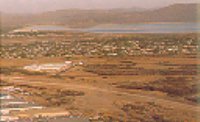


In a country poorly endowed with water resources, as characterised by erratic rainfall and frequent severe drought conditions, coupled with unfavourable topography in terms of source development and utilisation, the provision of affordable water remains a major challenge.
Due to rapid urban growth, considerable extensions to operations have been planned, with the capacity of the pipelines from this dam in Gaborone being increase.
Although seasonal rainfall was 50 percent below average, the water situation during the past year was slightly improved from that experienced in the previous year. With the national water master plan offering a longer term solution to the problem of water in the country, a design study is currently being undertaken for a proposed major dam at Letsibogo along the Motloutse River, and this is expected to be completed by 1996/97.
The objective of the Water Utilities Corporation, a parastatal organisation, is to plan for a provide adequate supplies of potable water in all areas of statutory responsibility on a commercially viable basis, including the approved non-designated areas, to meet reasonable domestic, institutional, commercial and industrial demands. This service contributes indirectly to improvement in the standard of living and also plays a catalytic role towards national economic development.
At inception in 1970, the total population supplied numbered approximately 30,000,. with water consumption averaging five megalitres per day. In contrast, statistics for 1993 reflect the total population supplied at 280 000, with daily consumption averaging 70 megalitres. This comparison determines a substantial increase in demand over the years, which has resultantly warranted the continual development of infrastructure.
A number of projects were accordingly completed during the year - these include the Gaborone Water supply Primary Assets, the Pitsenayne Wellfiedl Development, the design and inspection of the Accelerated Land Servicing Programme, and other reticulation infrastructure, to name but a few.
In line with its endeavour to provide adequate water supplies, the corporation plans to construct a second pipeline from Gaborone to Lobatse in order to improve and safeguard the Lobatse water supply. Electrical and mechanical components of the Selebi-Phikwe treatment works are to be replaced. with refurbishment and possible expansion of civil components, and storage and transmission pipeline capacities at Jwaneng will be increased. In an effort to control water pollution, a study was undertaken to delineate protection zones for major wellfields, aquifers and dams; the results of this study will assist in protecting water resources from increasing pollution risks.
The corporation has also undertaken implementation of an ongoing information technology strategy. Through a master information systems plan this strategy is able to define the role and infrastructure for information processing so as to support functional operations and decision-making.

 go back
go back